Nail fungus: Signs and symptoms
Nail fungus is a common nail condition. It can cause one or more nails to thicken and turn yellow, white, brown, or another color. Sometimes, the infected nail lifts and crumbles.
Where does nail fungus develop?
You can get nail fungus on one or more toenails or fingernails. However, nail fungus is much more common on toenails.
What does nail fungus look like?
Nail fungus changes the appearance of the infected nail(s). You can often spot nail fungus by looking for these common signs:
Color change
Brittle nail that cracks, splits, or crumbles
Buildup under a nail
Lifting, so the nail is no longer firmly attached
Thickened nail
Misshapen nail or nail falls off
Pain
Pictures of nail fungus
Color change
The first noticeable sign is often color change on part of a nail. It’s common to see yellow, brown, or white. You can also see orange, greenish black, or black. Color change usually begins at the tip of the nail and spreads toward the cuticle.
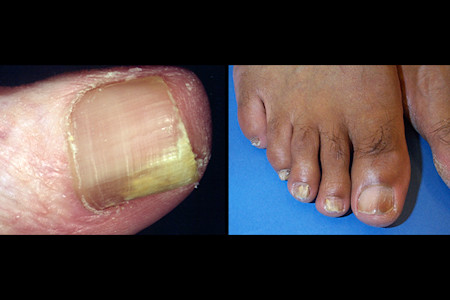
White nails
One type of nail fungus causes one or more white nails. The white color develops on the surface, so you may be able to scrape some of it off. The affected nails often feel soft, dry, and powdery. You may notice that the affected nails feel thinner. If you scrape a white nail, be sure to wash your hands. Nail fungus can spread easily and can infect other nails.
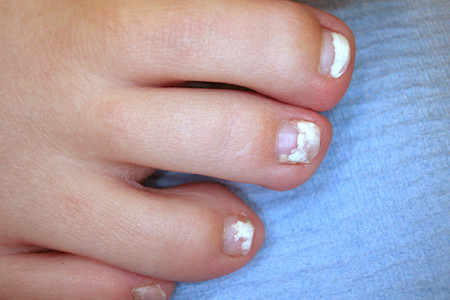
Streaks of either white and yellow or orange and brown
Here you can see yellow and white, along with another sign of nail fungus — redness on the skin around the nail. If you have a darker skin tone, infected skin around the nail tends to be a bit darker than your natural skin tone.

Brittle nail that cracks, splits, or crumbles
Here you can see common signs of nail fungus, such as a color change and discoloration on the skin. You can also see another telltale sign. Nail fungus can cause infected nails to split, crack, or crumble.

Nail lifting and buildup beneath a nail
Without treatment, the fungus can burrow deeper into the skin beneath a nail. Over time, this can cause the nail to lift or separate, and you may see build up under the nail.
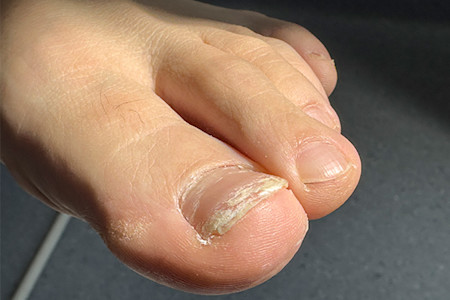
Nail thickening, usually causing brown or yellow discoloration
Over time, the fungal infection can cause infected nails to thicken. In darker skin tones, the thickened nail is often brown. People with lighter skin tones tend to see a thickened, yellowish nail.
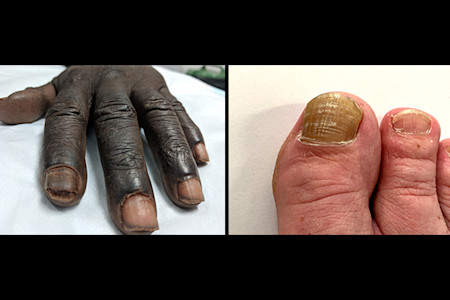
Misshapen or missing nail
Without treatment, nail fungus can burrow deep into the skin beneath a nail. This can damage the nail, causing a change to a nail’s shape. Sometimes, an infected nail falls off.
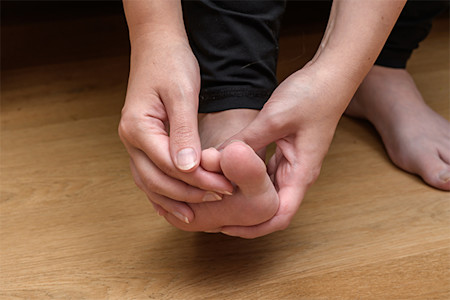
Pain
Nail fungus is usually painless. However, if it becomes severe, it can damage a nail and cause pain. When this happens, everyday activities, such as walking or standing, are often painful. Severe toenail fungus can also cause pain because shoes fit poorly.

If you think you have nail fungus, you may be wondering how you developed it. You’ll find out how people get this condition and who’s most likely to get it at Nail fungus: Causes.
Images
Images 1-3, 7: Produced with permission from ©DermNet 2025.
Image 4: Used with permission of the Journal of the American Academy of Dermatology
J Am Acad Dermatol. 2019 April;80:835-51.
Images 5, 6, 8–10: Getty Images
References
Falotico JM, Lipner SR. “Updated perspectives on the diagnosis and management of onychomycosis.” Clin Cosmet Investig Dermatol. 2022 Sep 15;15:1933-57.
Habif TP, Campbell JL, et al. “Tinea of the nails.” In: Dermatology DDxDeck. Mosby Elsevier, China, 2006: Card 72.
Kreijkamp-Kaspers S, Hawke K, et al. “Oral antifungal medication for toenail onychomycosis.” Cochrane Database Syst Rev. 2017 Jul 14;7(7):CD010031.
Leung AKC, Lam JM, et al. “Onychomycosis: An updated review.” Recent Pat Inflamm Allergy Drug Discov. 2020;14(1):32-45.
Written by:
Paula Ludmann, MS
Reviewed by:
William Warren Kwan, MD, FAAD
Shari Lipner, MD, PhD, FAAD
Temitayo Ogunleye, MD, FAAD
Last updated: 6/26/25
 Atopic dermatitis: More FDA-approved treatments
Atopic dermatitis: More FDA-approved treatments
 Biosimilars: 14 FAQs
Biosimilars: 14 FAQs
 How to trim your nails
How to trim your nails
 Relieve uncontrollably itchy skin
Relieve uncontrollably itchy skin
 Fade dark spots
Fade dark spots
 Untreatable razor bumps or acne?
Untreatable razor bumps or acne?
 Tattoo removal
Tattoo removal
 Scar treatment
Scar treatment
 Free materials to help raise skin cancer awareness
Free materials to help raise skin cancer awareness
 Dermatologist-approved lesson plans, activities you can use
Dermatologist-approved lesson plans, activities you can use
 Find a Dermatologist
Find a Dermatologist
 What is a dermatologist?
What is a dermatologist?